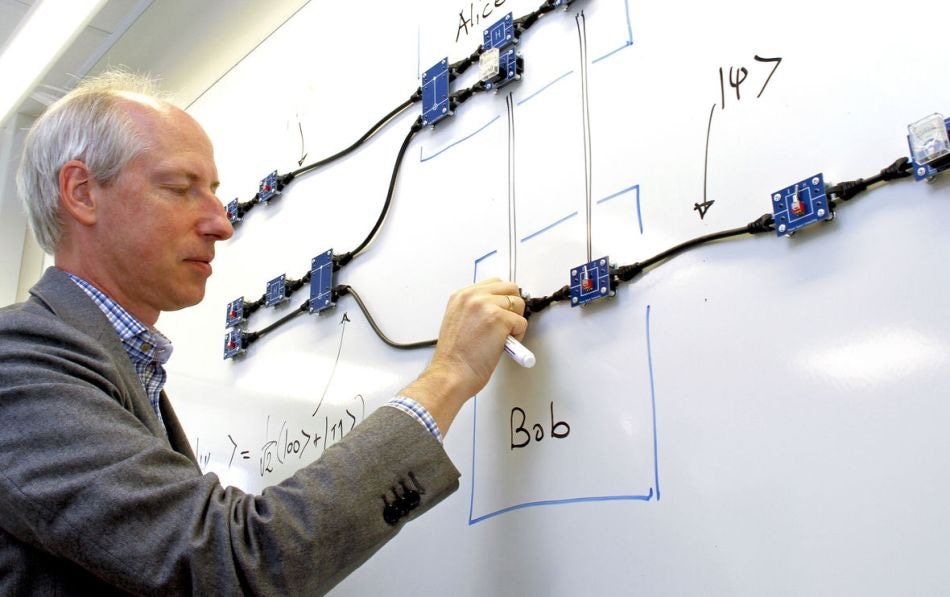Sep 4 2019
Researchers from Linköping University have demonstrated the way a quantum computer really works and have been able to simulate quantum computer properties in a classical computer. “Our results should be highly significant in determining how to build quantum computers,” stated Professor Jan-Åke Larsson.
 By simulating an additional degree of freedom in a classical computer, we can run some of the algorithms at the same speed as they would achieve in a quantum computer, says Professor Jan-Åke Larsson. (Image credit: Karl Öfverström)
By simulating an additional degree of freedom in a classical computer, we can run some of the algorithms at the same speed as they would achieve in a quantum computer, says Professor Jan-Åke Larsson. (Image credit: Karl Öfverström)
The vision of robust and superfast quantum computers has gained mileage again, with large resources being invested in studies in Sweden, Europe, and worldwide. Within a decade, a Swedish quantum computer will be developed, and the EU has nominated quantum technology one of its prime projects.
Currently, few effective algorithms are available for quantum computers; however, it is anticipated that the technology will have a vital role to play in simulations of physical, biological, and chemical systems that are far more complicated for even the most robust computers that are available at present.
A classical bit can take the value of only 1 or 0; by contrast, a quantum bit can take all values in between. In other words, this implies that it is not necessary for quantum computers to take as many operations for every calculation they perform.
Two Degrees of Freedom
Professor Jan-Åke Larsson and his doctoral student Niklas Johansson, in the Division for Information Coding at the Department of Electrical Engineering, Linköping University, have gained insights into what takes place in a quantum computer and why it is more robust compared to a classical computer. The study outcomes have been reported in the scientific journal Entropy.
We have shown that the major difference is that quantum computers have two degrees of freedom for each bit. By simulating an additional degree of freedom in a classical computer, we can run some of the algorithms at the same speed as they would achieve in a quantum computer.
Jan-Åke Larsson, Professor, Division for Information Coding, Department of Electrical Engineering, Linköping University
They have developed a simulation tool—Quantum Simulation Logic (QSL)—that allows them to simulate a quantum computer’s operations in a classical computer. The simulation tool includes one, and only one, property possessed by a quantum computer that a classical computer does not have: one additional degree of freedom for every bit that is part of the calculation.
Thus, each bit has two degrees of freedom: it can be compared with a mechanical system in which each part has two degrees of freedom—position and speed. In this case, we deal with computation bits—which carry information about the result of the function, and phase bits—which carry information about the structure of the function.
Jan-Åke Larsson, Professor, Division for Information Coding, Department of Electrical Engineering, Linköping University
Quantum Algorithms
The researchers have employed the simulation tool to analyze some of the quantum algorithms that control the structure of the function. A number of these algorithms operate as fast in the simulation as they would in a quantum computer.
The result shows that the higher speed in quantum computers comes from their ability to store, process and retrieve information in one additional information-carrying degree of freedom. This enables us to better understand how quantum computers work. Also, this knowledge should make it easier to build quantum computers, since we know which property is most important for the quantum computer to work as expected.
Jan-Åke Larsson, Professor, Division for Information Coding, Department of Electrical Engineering, Linköping University
Jan-Åke Larsson and his colleagues have also complemented their theoretical simulations with a physical version developed using electronic components. The gates are analogous to those used in quantum computers, and the toolkit simulates the way a quantum computer runs.
Using the tool, students, for instance, can simulate and gain insights into the way quantum teleportation and quantum cryptography work, as well as a few of the most standard quantum computing algorithms, like Shor’s algorithm for factorization. (The algorithm works in the existing version of the simulation but is likewise fast—or slow—as in classical computers).
The LiU researchers launched a start-up in 2017. Recently, the company has been included in a list drawn up by the online journal EU-startups of the 10 most fascinating start-ups in Europe that “cool down the crazy world of quantum computing.”